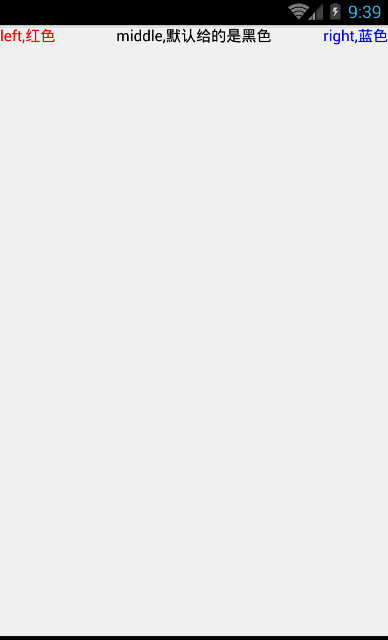自定义View之利用组合View实现复用
2016-07-21 21:29
621 查看
需求:很多UI界面中有相同的View单位,比如每个UI有相同的TitleBar。
利用androidannotations注入注解框架。
androidannotations框架的依赖导入:
至此,androidannotations添加依赖完成

先自定一个布局
一个线性布局,左边一个 TextView,中间一个TextView,右边一个TextView,(R.layout.custom)
在value文件夹下建立attrs.xml文件进行属性的自定义,这里只进行字体颜色和内容的定义,可以根据需求自行添加其他需要的(命名完全自定义,只是 作为中介承接,format代表此属性的 属性)
然后自定义一个类继承刚才布局的根ViewGroup,这里就用到了annotations进行简洁代码了
然后就可以进行复用了,有个地方要注意,用annotations进行注解的类,annotations会自动生成一个以”“结尾的类,比如上面的TitleBar,我们使用的是注释注解生成的TitleBar
在需要用到复用这个布局
(R.layout.activity_main)

然后可以给其设置监听
效果图:

其实这种方式颇有一番自定义View的风味了,只是在原有的view的基础上进行排列组合,虽然没有完全继承View进行各种方法的重写来的高大上和酷炫,但是也是很使用的一个小技巧.
利用androidannotations注入注解框架。
androidannotations框架的依赖导入:
//在app的build.gradle中加入
apply plugin: 'com.android.application'
apply plugin: 'android-apt'
def AAVersion = '3.3.2'
dependencies {
compile fileTree(include: ['*.jar'], dir: 'libs')
testCompile 'junit:junit:4.12'
compile 'com.android.support:appcompat-v7:23.1.0'
apt "org.androidannotations:androidannotations:$AAVersion"
compile "org.androidannotations:androidannotations-api:$AAVersion"
}
apt {
arguments {
androidManifestFile variant.outputs[0].processResources.manifestFile
// if you have multiple outputs (when using splits), you may want to have other index than 0
// you should set your package name here if you are using different application IDs
// resourcePackageName "your.package.name".
// You can set optional annotation processing options here, like these commented options:
// logLevel 'INFO'
// logFile '/var/log/aa.log'
}
}
//在整个project的build.gradle中加入
dependencies {
classpath 'com.android.tools.build:gradle:2.1.2'
classpath 'com.neenbedankt.gradle.plugins:android-apt:1.4'
// NOTE: Do not place your application dependencies here; they belong
// in the individual module build.gradle files
}至此,androidannotations添加依赖完成

先自定一个布局
一个线性布局,左边一个 TextView,中间一个TextView,右边一个TextView,(R.layout.custom)
<?xml version="1.0" encoding="utf-8"?> <LinearLayout xmlns:android="http://schemas.android.com/apk/res/android" android:layout_width="match_parent" android:layout_height="match_parent"> <TextView android:id="@+id/tv_left" android:layout_weight="2" android:layout_width="0dp" android:layout_height="match_parent" /> <TextView android:id="@+id/tv_middle" android:layout_weight="6" android:layout_width="0dp" android:layout_height="match_parent" android:gravity="center_horizontal"/> <TextView android:id="@+id/tv_right" android:layout_weight="2" android:layout_width="0dp" android:layout_height="match_parent" android:gravity="right"/> </LinearLayout>
在value文件夹下建立attrs.xml文件进行属性的自定义,这里只进行字体颜色和内容的定义,可以根据需求自行添加其他需要的(命名完全自定义,只是 作为中介承接,format代表此属性的 属性)
<?xml version="1.0" encoding="utf-8"?> <resources> <declare-styleable name="TitleBar" > <!-- 此属性用来表示右边TextView的内容 --> <attr name="text_right" format="string"/> <!-- 此属性用来表示左边TextView的内容 --> <attr name="text_lfet" format="string"/> !-- 此属性用来表示中间TextView的内容 --> <attr name="text_title" format="string"/> <!-- 此属性用来表示右边TextView的颜色 --> <attr name="color_right" format="color"/> <!-- 此属性用来表示左边TextView的颜色 --> <attr name="color_left" format="color"/> <!-- 此属性用来表示中间TextView的颜色 --> <attr name="color_title" format="color"/> </declare-styleable> </resources>
然后自定义一个类继承刚才布局的根ViewGroup,这里就用到了annotations进行简洁代码了
package yidianlingzj.com.viewdemo;
import android.content.Context;
import android.content.res.TypedArray;
import android.util.AttributeSet;
import android.view.View;
import android.widget.LinearLayout;
import android.widget.TextView;
import org.androidannotations.annotations.AfterViews;
import org.androidannotations.annotations.EViewGroup;
import org.androidannotations.annotations.ViewById;
@EViewGroup(R.layout.ui_custom)
public class TitleBar extends LinearLayout {
@ViewById
TextView tv_left,tv_middle,tv_right;
String mTitle, mLeft, mRight;
int mTitle_color, mLeft_color, mRight_color;
//回调监听
TitleBarListener mLeftListener,mMiddleListener,mRightListener;
public TitleBar(Context context) {
super(context);
initRoot(null,0);
}
public TitleBar(Context context, AttributeSet attrs) {
super(context, attrs);
initRoot(attrs,0);
}
public TitleBar(Context context, AttributeSet attrs, int defStyleAttr) {
super(context, attrs, defStyleAttr);
initRoot(attrs, defStyleAttr);
}
void initRoot(AttributeSet attrs, int defStyleAttr) {
final TypedArray typedArray=getContext().obtainStyledAttributes(
attrs,R.styleable.TitleBar,defStyleAttr,0
);
//获得对应的内容
mTitle=typedArray.getString(R.styleable.TitleBar_text_title);
mLeft=typedArray.getString(R.styleable.TitleBar_text_lfet);
mRight=typedArray.getString(R.styleable.TitleBar_text_right);
//获得对应的颜色值,默认为黑色
mTitle_color=typedArray.getColor(R.styleable.TitleBar_color_title,0xff000000);
mLeft_color=typedArray.getColor(R.styleable.TitleBar_color_left,0xff000000);
mRight_color=typedArray.getColor(R.styleable.TitleBar_color_right,0xff000000);
typedArray.recycle();
}
@AfterViews
void setupView(){
tv_left.setText(mLeft);
tv_middle.setText(mTitle);
tv_right.setText(mRight);
tv_left.setTextColor(mLeft_color);
tv_middle.setTextColor(mTitle_color);
tv_right.setTextColor(mRight_color);
setListener();
}
private void setListener(){
tv_left.setOnClickListener(new OnClickListener() {
@Override
public void onClick(View view) {
if(mLeftListener!=null){
mLeftListener.click(view);
}
}
});
tv_middle.setOnClickListener(new OnClickListener() {
@Override
public void onClick(View view) {
if(mMiddleListener!=null){
mMiddleListener.click(view);
}
}
});
tv_right.setOnClickListener(new OnClickListener() {
@Override
public void onClick(View view) {
if(mRightListener!=null){
mRightListener.click(view);
}
}
});
}
public void setmLeftListener(TitleBarListener mLeftListener){
this.mLeftListener=mLeftListener;
}
public void setmMiddleListener(TitleBarListener mMiddleListener){
this.mMiddleListener=mMiddleListener;
}
public void setmRightListener(TitleBarListener mRightListener){
this.mRightListener=mRightListener;
}
//监听回调
interface TitleBarListener{
void click(View view);
}
}然后就可以进行复用了,有个地方要注意,用annotations进行注解的类,annotations会自动生成一个以”“结尾的类,比如上面的TitleBar,我们使用的是注释注解生成的TitleBar
在需要用到复用这个布局
(R.layout.activity_main)
<?xml version="1.0" encoding="utf-8"?> <LinearLayout xmlns:android="http://schemas.android.com/apk/res/android" android:layout_width="match_parent" android:layout_height="match_parent" xmlns:app="http://schemas.android.com/apk/res-auto" android:orientation="vertical"> <yidianlingzj.com.viewdemo.TitleBar_ android:id="@+id/main_tb" android:layout_width="match_parent" android:layout_height="65dp" app:text_lfet="left,红色" app:text_title="middle,默认给的是黑色" app:text_right="right,蓝色" app:color_left="#ff0000" app:color_right="#0000ff"/> </LinearLayout>

然后可以给其设置监听
@EActivity(R.layout.activity_main)
public class MainActivity extends AppCompatActivity {
@ViewById
TitleBar main_tb;
@AfterViews
void setListener(){
main_tb.setmLeftListener(new TitleBar.TitleBarListener() {
@Override
public void click(View view) {
Toast.makeText(MainActivity.this, "点击了left", Toast.LENGTH_SHORT).show();
}
});
main_tb.setmMiddleListener(new TitleBar.TitleBarListener() {
@Override
public void click(View view) {
Toast.makeText(MainActivity.this, "点击了middle", Toast.LENGTH_SHORT).show();
}
});
main_tb.setmRightListener(new TitleBar.TitleBarListener() {
@Override
public void click(View view) {
Toast.makeText(MainActivity.this, "点击了right", Toast.LENGTH_SHORT).show();
}
});
}
}效果图:

其实这种方式颇有一番自定义View的风味了,只是在原有的view的基础上进行排列组合,虽然没有完全继承View进行各种方法的重写来的高大上和酷炫,但是也是很使用的一个小技巧.
新技能GET√
相关文章推荐
- String、String.valueOf、toString 它们三者的区别总结
- java----单例模式
- mysql1主多从配置
- CodeForces599BSpongebob and Joke
- Maximum Depth of Binary Tree
- Libgdx之Pixmap
- windows 堆管理
- js原生rotate函数
- java学习之路之基本语法-变量-练习题
- PAT-B 1013. 数素数
- bzoj1499(这道题改天重做,dp+单调队列优化)
- Spark总结(一)
- 源码分析-java-LinkedList
- LinkedHashMap
- 在microSD卡上扩展文件系统分区方法
- Android性能优化:谈谈Bitmap的内存管理与优化
- mysql中字符串运算
- PAT-B 1012. 数字分类
- 【经典】仙岛求药(一)
- .NET基础架构方法—DataTableToExcel通用方法
